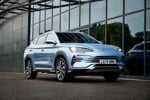The criteria valued by consumers looking to purchase a new vehicle is changing.
Previously, they would have checked the horsepower and 0-60 mph figures in the dealership or online, but now they’re asking how the vehicle can improve their experience for commutes, or how it can entertain young passengers while they are on the move.
The value has shifted from traditional criteria to one that is user-centric, more aligned with the consumer tech industry: from RPM to EPM, or ‘Experiences Per Mile’. Electrification and the progress of autonomy are compounding this shift and accelerating the change.
Traditionally, the car purchase process includes reviewing a long list of standard and optional features; but it’s not straight-forward for the consumer to understand how these individual technologies will benefit their in-car experience, nor how they relate to their personal usage of the vehicle.
Moreover, it’s complicated to compare them across different marques and models to find the best solution for their specific needs.
An exploratory study conducted by market research consultancy IPSOS, commissioned by the Experiences Per Mile (EPM) Advisory Council, has indicated that there is value in developing an industry-wide metric that assists consumers to compare individual vehicle models based on how well they help users meet their in-vehicle needs across different types of journeys.
For example, a family seeking a vehicle that is primarily used for school drop-offs and running errands could quickly and easily focus in on models that are high scoring for positive experiences during these specific trip types.
Different goals for different journey types
The research surveyed almost 2,000 owners of premium or mainstream compact SUVs, capturing how they felt about their in-vehicle experience holistically rather than focusing on individual features.
The first key finding was that respondents have different in-vehicle goals that vary by trip type – such as school drop-offs, commuting or road trips – and that they can clearly distinguish them.
These goals can be summarised as: connecting with others, being productive, feeling good, de-stressing/relaxing, being entertained, or finding privacy.
For example, commuting puts more priority weighting on the goals of feeling good, finding privacy, and connecting and communicating with others.
Perhaps as expected, the findings show that making full use of in-car technology helps consumers meet their trip goals, leading to higher experience scores overall.
OEMs and car dealers that are focused on ensuring customers are trained and comfortable using the latest technology are therefore more likely to have satisfied users.
Additionally, it was found that there is not a huge disparity between the fulfilment scores for premium and mainstream vehicles, but that there is variety between the models within each category.
The EPM Index
Following the findings, a possible metric has been outlined. Named the ‘EPM Index,’ it places a score of between 0-100 on a vehicle based on its ability to deliver across priority goals for frequent journey types.
The formula to calculate this is based on the vehicle’s experiential net score for a particular goal, multiplied by the weighting that goal has for a particular trip type.
The sum of the weighted scores calculates the EPM Index, with each journey type having a specific EPM score.
The vision is that each new vehicle on the market could be given such a rating that can be displayed by OEMs and retailers.
Therefore, a consumer could visit a dealer, quickly and easily access this information to compare models and find vehicles with the highest EPM Index for their most common trip types.
It would make refining their search much simpler.
Someone regularly on the road for work would seek a vehicle that scores high for commuting, but those needing a family car might look for vehicles scoring highly for giving others lifts and for running errands.
A tool for OEMs and retailers, too
Not only would this information prove useful for consumers, both retailers and OEMs can benefit from such a rating, which would be a first-of-its-kind.
For future models, OEMs can utilise this information to identify and improve features and technologies that fulfil goals associated with trip types. For retailers, a greater focus on customer training of these technologies would help elicit a more fulfilling experience.
From what we are seeing, there is value in this measurement and OEMs see its potential to build understanding and create stronger brand connections with motorists seeking consumer-centric in-vehicle experiences.
Today, such a tool could be used to benchmark current products, but ultimately it has the potential to help in the development of more fulfilling future vehicle experiences and support consumers in purchase decisions.
Author: Tom Rivers is vice president of global marketing at automotive connected technology provider HARMAN and is a leader on the Board of Directors for the EPM Advisory Council.















Login to comment
Comments
No comments have been made yet.